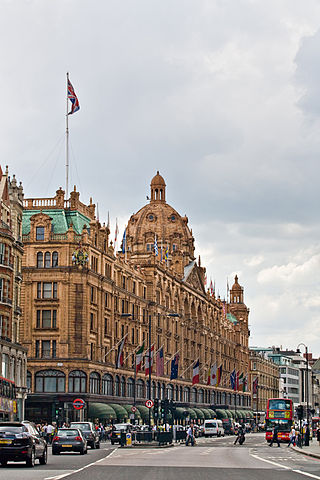
Knightsbridge is a residential and retail district in central London, south of Hyde Park. It is identified in the London Plan as one of two international retail centres in London, alongside the West End. Knightsbridge is also the name of the roadway which runs near the south side of Hyde Park from Hyde Park Corner.

Park Hill is a housing estate in Sheffield, South Yorkshire, England. It was built between 1957 and 1961, and in 1998 was given Grade II* listed building status. Following a period of decline, the estate is being renovated by developers Urban Splash into a mostly private mixed-tenure estate made up of homes for market rent, private sale, shared ownership, and student housing while around a quarter of the units in the development will be social housing. The renovation was shortlisted for both the 2013 and 2024 RIBA Stirling Prize, for the first and second phases of the redevelopment respectively. The Estate falls within the Manor Castle ward of the City. Park Hill is also the name of the area in which the flats are sited. The name relates to the deer park attached to Sheffield Manor Lodge, the remnant of which is now known as Norfolk Park.

The Shell Centre in London is the global headquarters of oil major Shell plc. It is located on Belvedere Road in the London Borough of Lambeth. It is a prominent feature on the South Bank of the River Thames near County Hall, and now forms the backdrop to the London Eye.

Hyde Park Corner is between Knightsbridge, Belgravia and Mayfair in London, England. It primarily refers to a major road junction at the southeastern corner of Hyde Park, that was originally planned by architect Decimus Burton. The junction includes a broad green-space roundabout in its centre, which is now the setting for Burton's triumphal Wellington Arch.

Ernő Goldfinger was a Hungarian-born British architect and designer of furniture. He moved to the United Kingdom in the 1930s, and became a key member of the Modernist architectural movement. He is most prominently remembered for designing residential tower blocks, some of which are now listed buildings.

The Marsham Towers were three government buildings at the corner of Marsham Street and Great Peter Street in Westminster, London. They served as the headquarters of the Department of the Environment.

Connaught Square in London, England, was the first square of city houses to be built in Bayswater. It is named after a royal, the Earl of Connaught who was from 1805 until death in 1834 the second and last Duke of Gloucester and Edinburgh, and who maintained his fringe-of-London house and grounds on the land of this square and Gloucester Square. Its appearance is essentially the same as in the 1820s. Its south-east is 115 metres north of Hyde Park and the same west of Edgware Road. This point is 302 m (991 ft) WNW of Marble Arch, which sits on a very large green roundabout marking the western end of Oxford Street. Connaught Street runs along is northern end.
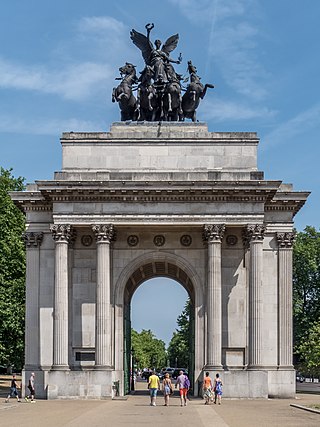
The Wellington Arch, also known as the Constitution Arch or (originally) as the Green Park Arch, is a Grade I-listed triumphal arch by Decimus Burton that forms a centrepiece of Hyde Park Corner in central London, between the corner where Hyde Park meets Green Park. The Arch stands on a large green-space traffic island with crossings for pedestrian access. From its construction (1826–1830) the arch stood in a nearby location, slightly to the east, directly across from Burton's Ionic screen entrance to Hyde Park; it was moved a short distance to its current site at the top of the Constitution Hill road in 1882–1883. The triumphal arch originally supported a colossal equestrian statue of the 1st Duke of Wellington by the sculptor Matthew Cotes Wyatt, acquiring its name as a result. Peace descending on the Quadriga of War by sculptor Adrian Jones, a bronze of the Goddess of Victory Nike riding a quadriga, has surmounted the arch since 1912.

Central Park is a 51-storey office tower in Perth, Western Australia. The building measures 226 m (741 ft) from its base at St Georges Terrace to the roof, and 249 m (817 ft) to the tip of its communications mast. Upon its completion in 1992, the tower became the tallest building in Perth, and was the 4th tallest in Australia from then till 2005. It is also currently the sixteenth tallest building in Australia and the tallest building in the western half of Australia.
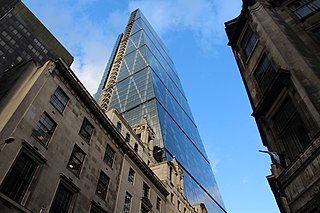
Leadenhall Street is a street in the City of London. It is about 1⁄3-mile-long (0.54 km) and links Cornhill in the west to Aldgate in the east. It was formerly the start of the A11 road from London to Norwich, but that route now starts further east at Aldgate.
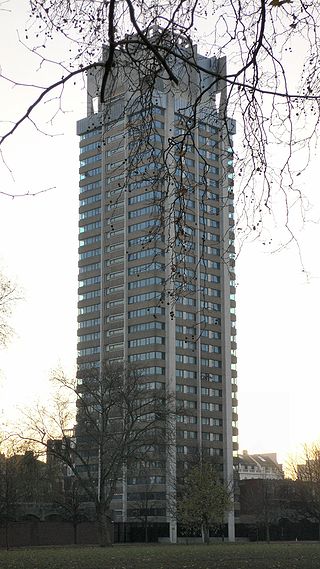
The Hyde Park Barracks are in Knightsbridge in central London, on the southern edge of Hyde Park. They were often known as Knightsbridge Barracks and this name is still sometimes used informally. The barracks are 3⁄4 mile (1.2 km) from Buckingham Palace, enabling the officers and soldiers of the Household Cavalry to be available to respond speedily to any emergency at the Palace, practice drills at Horse Guards Parade or beyond and conduct other more ceremonial duties.

The Calders is a residential neighbourhood in Edinburgh, Scotland – not to be confused with the Calders of West Lothian aka West Calder, Mid Calder and East Calder, three separate villages. It is sometimes considered to be part of Wester Hailes or Sighthill, larger developments to its south and east respectively. From 2007 to 2017, it fell within the Sighthill/Gorgie multi-member ward of the City of Edinburgh Council administration along with Sighthill, but following a boundary change has been in the Pentland Hills ward since then, along with Wester Hailes.
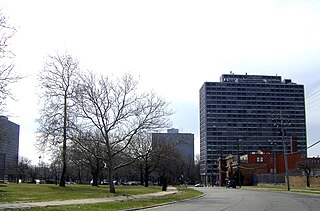
Lafayette Park is a neighborhood located east of Downtown Detroit. It contains a residential area of some 4,900 people and covers 0.37 sq mi.

The Mandarin Oriental Hyde Park, London, is a historic five-star hotel located in the Knightsbridge area of London, owned and managed by Mandarin Oriental Hotel Group. The Edwardian-style building opened in 1889 as apartments and was converted to a hotel in 1902.
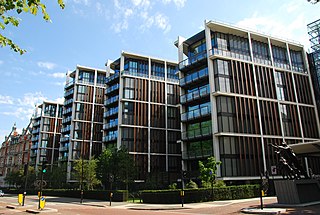
One Hyde Park is a major residential and retail complex located in Knightsbridge, London. The development includes three retail units and 86 residential properties, with prices starting at around £5 million for a 1 bedroom apartment, and penthouses selling for almost £200 million, it is generally considered the most exclusive apartment building in the world.
The 1950s and 1960s saw the construction of numerous brutalist apartment blocks in Sheffield, England. The Sheffield City Council had been clearing inner-city residential slums since the early 1900s. Prior to the 1950s these slums were replaced with low-rise council housing, mostly constructed in new estates on the edge of the city. By the mid-1950s the establishment of a green belt had led to a shortage of available land on the edges of the city, whilst the government increased subsidies for the construction of high-rise apartment towers on former slum land, so the council began to construct high-rise inner city estates, adopting modernist designs and industrialised construction techniques, culminating in the construction of the award-winning Gleadless Valley and Park Hill estates.

Henry Thomas Cadbury-Brown RA, also known as H.T. Cadbury-Brown and Jim Cadbury-Brown, was an English architect. He was educated at the Architecture Association where he was influenced by the architecture of Le Corbusier and Walter Gropius. After graduating he worked for architect Ernő Goldfinger and became his lifelong friend. He went on to set up his own successful practice.

Scotch Corner is the road junction of Knightsbridge with the inceptive Brompton Road and Sloane Street. It is within the City of Westminster, facing the Royal Borough of Kensington and Chelsea.

The Rush of Green, also known as Pan or The Bowater House Group, was the last sculpture completed by Jacob Epstein before his death at his home in Hyde Park Gate on 19 August 1959. The sculpture group includes a long-limbed family – father, mother, son and dog – rushing towards Hyde Park, encouraged by the Greek god Pan playing his pipes. It was cast in bronze posthumously and installed in 1961 on a plinth separating the carriageways of Edinburgh Gate beneath Bowater House. The sculpture was removed when Bowater House was demolished in 2006 and reinstalled near the building which replaced it, One Hyde Park, in 2010. The sculpture was granted Grade II listed status in January 2016, giving it legal protection against unauthorised alteration or removal.


















